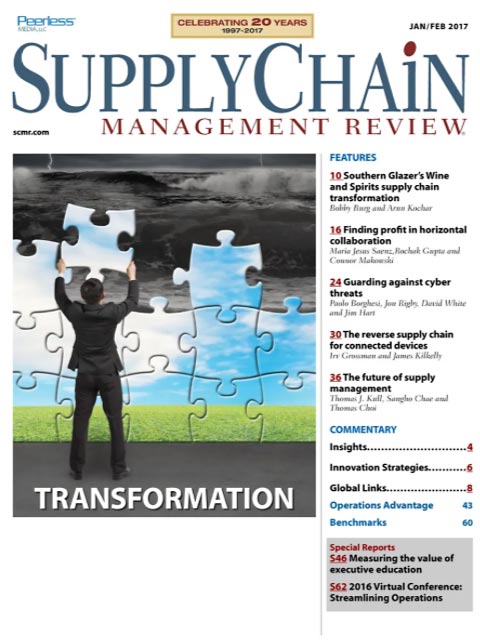Sorry, but your login has failed. Please recheck your login information and resubmit. If your subscription has expired, renew here.
January-February 2017
Transformation is a topic that comes up in almost every conversation I have with supply chain managers these days. Executives from companies as diverse as J&J Vision Care, the division of Johnson & Johnson that manufactures contact lenses, and Thrive Markets, a startup selling health and wellness products to its members, have talked about how they have had to remake their supply chains to meet new customer demands. Transformation is also the theme of this issue of SCMR. Browse this issue archive.Need Help? Contact customer service 847-559-7581 More options
Benchmarking is a well-known tool for comparing the performance and practices of a business entity against those of others.
Successfully implementing benchmarking canresult in benefits for an organization, including:
- facilitating comparisons across business units;
- accelerating restructuring and change;
- encouraging innovation;
- enabling objective comparisons; and
- improving productivity and quality
Although benchmarking presents the opportunity to obtain rich and beneficial information, organizations may not be making full use of this tool. To better understand how organizations are using benchmarking and the results of their efforts, APQC conducted a survey of 319 respondents representing a variety of industries and organizational functions. Nearly 19% of those survey respondents indicated that their roles are within a supply chain function, which APQC defined as the logistics, operations, supply chain planning, manufacturing and procurement functions of an organization.
APQC then compared the benchmarking practices of supply chain functions against the practices of all other types of organizational functions. The results indicate that supply chain functions have integrated benchmarking into their decision-making and improvement efforts more so than other functions but they have room for improvement when it comes to identifying the financial impact of benchmarking and involving more employees.

This complete article is available to subscribers only.
Log in now for full access or start your PLUS+ subscription for instant access.
SC
MR
Sorry, but your login has failed. Please recheck your login information and resubmit. If your subscription has expired, renew here.
January-February 2017
Transformation is a topic that comes up in almost every conversation I have with supply chain managers these days. Executives from companies as diverse as J&J Vision Care, the division of Johnson & Johnson… Browse this issue archive. Access your online digital edition. Download a PDF file of the January-February 2017 issue.Benchmarking is a well-known tool for comparing the performance and practices of a business entity against those of others.
Successfully implementing benchmarking canresult in benefits for an organization, including:
- facilitating comparisons across business units;
- accelerating restructuring and change;
- encouraging innovation;
- enabling objective comparisons; and
- improving productivity and quality
Although benchmarking presents the opportunity to obtain rich and beneficial information, organizations may not be making full use of this tool. To better understand how organizations are using benchmarking and the results of their efforts, APQC conducted a survey of 319 respondents representing a variety of industries and organizational functions. Nearly 19% of those survey respondents indicated that their roles are within a supply chain function, which APQC defined as the logistics, operations, supply chain planning, manufacturing and procurement functions of an organization.
APQC then compared the benchmarking practices of supply chain functions against the practices of all other types of organizational functions. The results indicate that supply chain functions have integrated benchmarking into their decision-making and improvement efforts more so than other functions but they have room for improvement when it comes to identifying the financial impact of benchmarking and involving more employees.
SC
MR


Latest Supply Chain News
- Tech investments bring revenue increases, survey finds
- Survey reveals strategies for addressing supply chain, logistics labor shortages
- Israel, Ukraine aid package to increase pressure on aerospace and defense supply chains
- How CPG brands can deliver on supplier diversity promises
- How S&OP provides the answer to in-demand products
- More News
Latest Resources

 Explore
Explore
Topics
Latest Supply Chain News
- Tech investments bring revenue increases, survey finds
- Survey reveals strategies for addressing supply chain, logistics labor shortages
- Israel, Ukraine aid package to increase pressure on aerospace and defense supply chains
- How CPG brands can deliver on supplier diversity promises
- How S&OP provides the answer to in-demand products
- AI, virtual reality is bringing experiential learning into the modern age
- More latest news
Latest Resources

Subscribe

Supply Chain Management Review delivers the best industry content.

Editors’ Picks





